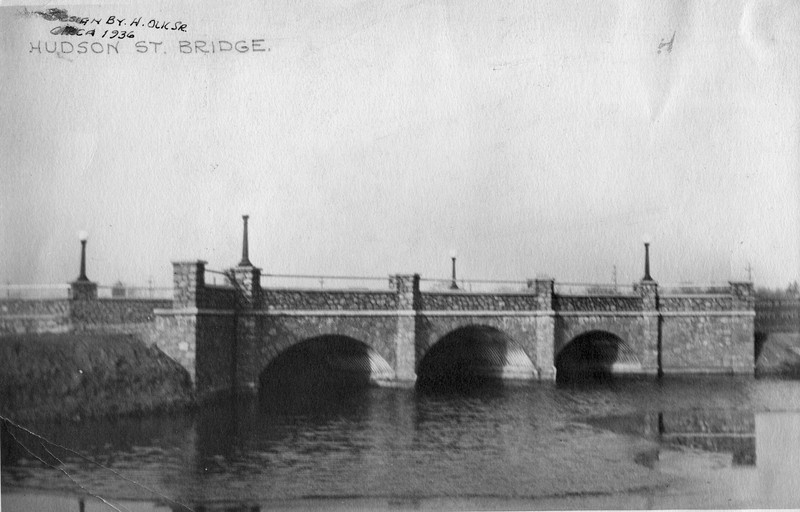The Fourth Avenue Dam
Introduction
Text-to-speech Audio
A dam originally constructed on this site in 1879 created a lake on Spring Brook that played a major role in Antigo’s early development. The dense forests and demand for lumber after the Civil War attracted speculators and lumbermen. Lumber mills require a mill pond in which to store logs. The lake and the river have been centerpieces of Antigo’s development from the first home built near this site to the sawmills and industry situated along the lakeshore in the 1920s to infrastructure improvements of the Depression era up to the 21st century and the recreational facilities the area provides.
Images
The current dam at Fourth Ave. replaced the original one built at this site in1879. This dam was built in 1936, using FERA funds.

The Antigo Lumber Company was one of many sawmills in and around Kellogg’s Pond (now called Antigo Lake).

Kellogg’s Pond skating area and warming house were popular recreational sites for decades beginning in the mid-1920s.

Harvesting ice from Kellogg’s Pond for refrigeration was a major industry in the 1930s.

The Hudson Street Bridge is the grandest of Antigo’s infrastructure projects of FDR’s New Deal funded by FERA and is seen east of the dam. It has recently been restored.

The boardwalk is part of the Spring Brook Trail that winds past the dam and through woods and wetlands. The trail includes recreational areas used year-round.

Backstory and Context
Text-to-speech Audio
Francis Deleglise was a Civil War veteran (1) who trained as a surveyor upon his return to Appleton. He worked as a timber cruiser and brought his family from Appleton to this site in 1878, to a cabin built a year earlier. He brought his family to an area inhabited by the Ojibwe and started the development of a new city, which he named Springbrook. It was later renamed Antigo after the Ojibwe phrase describing the region: “Nequi-Antigo-Seebeh”, variously translated as “where the river winds past evergreens” (2). The cabin has since been moved to the museum grounds and been restored. (3)
Deleglise convinced Louis and Joseph Novotny to move their sawmill from Wausau to Antigo to establish Antigo’s first sawmill. He allowed the Novotny brothers to build a seven-foot dam at this site and flood the land which he now owned. In 1883 the Novotny mill was purchased by T.D. Kellogg and the lake became known as Kellogg’s Pond. (4) (It is now known as Antigo Lake.) A map of Antigo from 1893 in the Langlade County historical Society Museum shows that the north shore of the lake supported the Kellogg mill, the Wisconsin Handle Manufacturing Co. (broom handles), the Antigo Screen Door Co., and the Frost Veneer & Seating Co. Just south of the dam, along Spring Brook were the Crocker Chair Co., the Weed Sawmill, and a barrel staves and headings manufacturer. Several other sawmills were later established in the area. (4)
In winter, the frozen lake saw different activities. For many years the city established and maintained a skating area and warming hut in a portion of the lake set aside for recreational use. In another region of the lake, the Healy Ice Company harvested ice for use as a refrigerant by households and food manufacturers. In 1932 Healy reported that, in that year, he stored over 8,000 tons of ice at his two ice houses nearby for his patrons. (5) Likely the biggest single consumer of ice from Kellogg’s Pond was the Chicago & Northwestern Railroad which had its division headquarters in Antigo. (6) An ice house at the Antigo railyards stored 3,500 tons of ice while an additional 14 rail cars of ice were shipped to the Watersmeet, Michigan for storage. In summer, Chicago & Northwestern Railroad refrigerated freight cars and airconditioned passenger cars throughout northern Wisconsin were cooled with ice from Kellogg’s Pond.
While the wood products manufacturing thrived, it also created ecological damage which would eventually have to be addressed. By the1920s the detritus from the various mills was affecting the water quality and the shoreline. City officials in 1923 hired a landscape architectural firm to develop a plan to revitalize the lake. (7) The plan would not be implemented until 1936 with financial help from Depression era funding. (8)
In 1932, with the United States mired in the Great Depression, President Franklin Delano Roosevelt instituted many projects to improve infrastructure and provide work for the unemployed, to the benefit of the nation, including Wisconsin. (9) One program, the Federal Emergency Relief Agency (FERA) provided Antigo with funds for a number of public works along the shores of Spring Brook and Kellogg’s Pond. One of these was the rebuilding of the dam at this site in 1936. Other dams, ten bridges, and the shoring up of the banks of Spring Brook were created with FERA funds. The grandest bridge is the Hudson Street Bridge, which can be seen to the east from this site and which was also completed in 1936. (10)
Today, this site is a trailhead of a walking/bicycle trail, following Spring Brook and the north shore of Antigo Lake. The trail, begun in 2009 and with plans to expand, winds for about 3 miles, through wetlands and woods, as well as adjacent to city parks and streets. Displays along the trail include public art and interpretive signs describing the history and nature of the area.
Sources
(1) http://langladehistory.com/CivilWar.html
(2) Robert M. Dessureau History of Langlade County Wisconsin, Berner Brothers Publishing Company, 1922. page 99.
(3) http://langladehistory.com/Antigo's%20First%20Home%20The%20Deleglise%20Cabin.pdf
(4) Robert M. Dessureau History of Langlade County Wisconsin, Berner Brothers Publishing Company, 1922. page 50.
(5) Antigo Daily Journal February 2, 1932, Page 3
(6) http://langladehistory.com/Antigo-%20A%20Railroad%20Town%20and%20the%20C&NW.pdf
(7) Antigo Daily Journal Oct. 30 1923. Page 1
(8) Antigo Daily Journal March 2, 1936. Page 1
(9) https://recollectionwisconsin.org/franklin-delano-roosevelts-new-deal-programs
(10) Antigo Daily Journal August 17, 1934. Page 1
